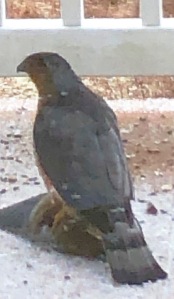By Barbara Walvoord
First published in Lathrop Lamp Post for Jan. 12-18, 2019
Never mind Lathrop’s new “No hunting” signs. There’s LOTS of hunting going on. Resident Betty Schaffer, on east campus Huckleberry Lane, reported on Jan. 3: “A hawk killed a mourning dove on my porch, and my daughter took this picture. It stayed this way awhile and we didn’t know what it would do. It pecked sometimes at the bird under it, which was still moving a little. Then it surprised us by flying off with the dove.” It’s a Cooper’s hawk.
Members of its genus, Accipiter, hunt mostly birds, and they are beautifully made for that task.
Sibley’s Guide to Bird Life and Behavior—a Christmas gift from my daughter and granddaughters—shows what an efficient bird hunter an accipiter is (pp. 215-216).
Accipiters hunt in forests and open woodlands and along forest edges—like much of Lathrop’s land. Eyesight up to eight times that of humans helps accipiters spot a bird from up to a mile away. They make “short flights between concealed perches, dodging through cover to stay out of sight,” their long tails increasing their maneuverability. Then they “sit in a semi-concealed spot for a minute or more to search for moving prey.” Sometimes an accipiter soars high above, then folds its wings very close to its body and plummets toward its prey. “At the last second, the hawk swings its feet forward and swerves to capture the prey.”
“During a kill, an accipiter grabs the prey with its feet, extends its long legs away from the body to protect its head and eyes, and repeatedly punctures the victim with its long, penetrating claws until the prey stops struggling. An accipiter does not use its beak in killing, but only for plucking and feeding on prey once it is dead.”
We welcome these efficient, beautifully-made hunters to our Lathrop land, and we protect their habitat, the birds they eat, the insects and native fruits the birds eat, and the native plants the insects eat, in the complex webs of life to which we, our land, and our creatures, all belong.


